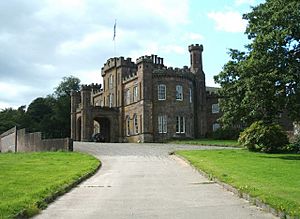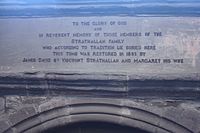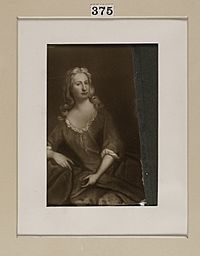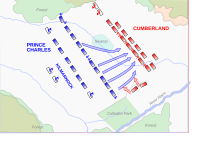William Drummond, 4th Viscount Strathallan facts for kids
Quick facts for kids
William Drummond, 4th Viscount Strathallan
|
|
|---|---|

Strathallan Castle
|
|
| Tenure | 1712 to 1746 |
| Predecessor | William Strathallan, 3rd Viscount Strathallan |
| Successor | James Drummond (1722-1765), de jure 5th Viscount Strahallan |
| Born | William Drummond 10 June 1690 Machany House, Perthshire |
| Died | 16 April 1746 (aged 55) Battle of Culloden |
| Cause of death | Killed at Culloden |
| Buried | Dunblane Cathedral |
| Nationality | Scots |
| Residence | Strathallan Castle |
| Locality | Perthshire |
| Wars and battles | 1715 Jacobite Rising Sheriffmuir 1745 Jacobite Rising Prestonpans Falkirk Culloden † |
| Spouse(s) | Margaret Murray (1692-1773) |
| Issue | 13 children, including James (1722-1765), William (1724-1772), Henry (1730-1795) and Robert (1728-1804) |
| Parents | Sir John Drummond of Machany (died 1707) Margaret Stewart of Innernytie |
William Drummond, 4th Viscount Strathallan (1690 – 16 April 1746) was a Scottish nobleman and a supporter of the Jacobite cause. He fought in the 1715 and 1745 uprisings, and sadly died during the Battle of Culloden.
After being forgiven for his part in the 1715 uprising, he helped Prince Charles in 1745. He gathered a group of cavalry (soldiers on horseback) and was made the Jacobite Governor of Perth. While the main Jacobite army went to England, he stayed in Scotland to find more soldiers. He was later replaced by Lord John Drummond in November 1745. William Drummond was killed at the Battle of Culloden in April 1746.
His oldest son, James (1722-1765), also joined the uprising and escaped to France. Because of his actions, a special law was passed in July 1746 that made him lose his titles and lands. After James died in 1765, his family bought back the lands. The family titles were given back to them in 1824.
Life Story
William Drummond was the oldest surviving son of Sir John Drummond of Machany (who lived around 1670-1707) and Margaret Stewart. He was born in 1690, though some records suggest his younger brother was born earlier.
The Drummond family were strong supporters of King James II & VII. The most important members of the family, James, Earl of Perth and John, Earl of Melfort, became Catholic and went into exile after a big change in power in 1688, known as the Glorious Revolution. In July 1690, Sir John's lands were taken by the Scottish government, but they were later returned.
William Drummond became Viscount Strathallan in 1711 after his cousin William passed away. A "Viscount" is a noble title, ranking below an Earl and above a Baron. The next year, he married Margaret Murray (1692-1773). They had 13 children together. Some of their children included James (1722-1765), William (1724-1772), Robert (1728-1804), and Henry (1730-1795).
James (1722-1765) lost his titles and lands in 1746 due to a special law called "attainder" and died while living in another country. Robert and Henry joined their uncle Andrew (1686-1769) to start a bank called Drummonds Bank. When James died in 1765, the government sold his lands, but his family bought them back. The title of Viscount Strathallan was given back to the family in 1824.
Margaret, William's wife, also came from a family that supported the Jacobites. Her father, William Murray, Lord Nairne, was the younger brother of John Murray, 1st Duke of Atholl. He also fought in the 1715 uprising. Lady Nairne (1669-1747), Margaret's mother, was a strong Jacobite supporter throughout her life. People believed she had a big influence on her husband, son-in-law (William Drummond), and nephews, including Tullibardine and Lord George Murray.
Military Career

William Drummond was part of a group of Stuart loyalists in Perthshire. This group included the Drummond and Murray families, who were often connected by marriage. William Drummond, his brother Thomas, Lord Nairne, and the Murray nephews were among the first to join the 1715 uprising. However, the Duke of Atholl chose not to take sides. William Drummond was at the Battle of Sheriffmuir, a battle where neither side clearly won. He was not captured or punished, and a law in 1717 (the 1717 Indemnity Act) gave a general pardon to everyone who took part.
Another Jacobite uprising in 1719 ended before it reached Perthshire. Over the next few years, many exiles, like Lord George Murray, were pardoned and came home. The government also built military roads in Scotland, which helped them control the Highlands better. The Jacobite cause continued mainly because of the strong family ties among a few families like the Drummonds.
In July 1745, Prince Charles landed on Eriskay and started the 1745 uprising in August. Using the new roads, the Jacobites marched to Edinburgh, reaching Perth on September 3. Here, William Drummond, Lord George Murray, and other family members joined them. William brought 36 cavalry soldiers and their helpers, known as the Perthshire or Strathallan's Horse. This was the only Jacobite cavalry unit at the Battle of Prestonpans in September. They did not take part in the battle, which lasted less than 20 minutes.
The Perthshire Horse, led by Lord Kilmarnock, went with the army when it invaded England. William Drummond stayed in Perth to find more soldiers. On November 21, Colonel Lachlan Maclachlan was sent back to Scotland to gather these new recruits and bring them to England. But by the time he arrived, William Drummond had been replaced by his cousin Lord John Drummond. Lord John changed these orders because, as a French army officer, he was told not to enter England until all British forts in Scotland were captured.
In early January, the Jacobites surrounded Stirling Castle to try and capture it. On January 13, Henry Hawley, the government commander in Scotland, marched north from Edinburgh to help the castle. The two armies met near Falkirk on January 17. Hawley thought there would be no fight that day. Around 1:00 pm, the Jacobites started to move forward. This began the Battle of Falkirk Muir, which happened in bad light and heavy snow. Both sides were confused during the battle. The Perthshire Horse did not fight in this battle. Even though it was a Jacobite victory, they did not follow up, allowing Hawley's troops to retreat safely.
On January 30, the government army started moving again. The Jacobites had lost many soldiers who left, so they stopped trying to capture Stirling Castle and went back to Inverness for the winter. Cumberland's army entered Aberdeen on February 27. Both sides stopped fighting until the weather got better. By spring, the Jacobites were low on food, money, and weapons. When Cumberland left Aberdeen on April 8, the Jacobite leaders decided that fighting a battle was their best chance.

By the time of the Battle of Culloden, the Perthshire Horse had about 70-80 men, split into two groups. However, their horses were not in good shape. The battle lasted less than an hour. After the Highlanders were pushed back, the government army moved forward against the other Jacobite soldiers. Their fight helped Prince Charles and his helpers get away. William Drummond's horse was killed under him, and he was killed in battle.
He is believed to be buried in Dunblane Cathedral, and his tomb was restored in 1893. His wife was held in Edinburgh Castle and then released in November 1746. His oldest son, James, escaped to France and lost his title and lands. He joined the Royal Ecossais, a group of Scottish exiles serving in the French army. The family bought back his lands when he died in 1765, but the title was not given back until 1824.
Sources
| Peerage of Scotland | ||
|---|---|---|
| Preceded by William Drummond |
Viscount Strathallan 1712–1746 |
Succeeded by James Drummond de jure |



